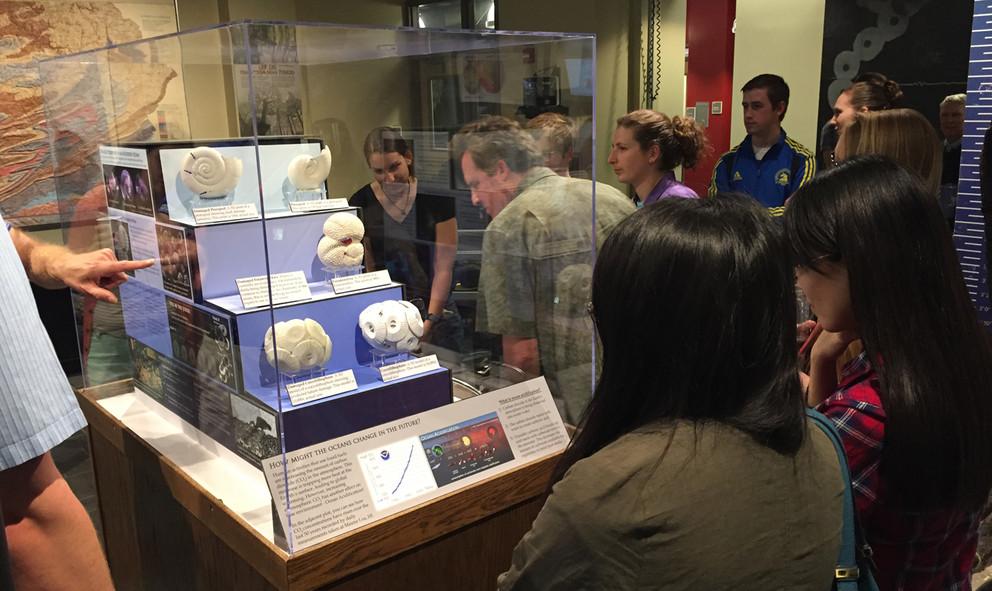by | May 10, 2016 | 3D Design, 3D Printing, Science & Technology |
We all know of the societal impact that 3D printing technology has had on various fields, from prototyping to medical research, but one vital application that is generally swept under the sea—so to speak—is its ability to aid in our current pollution crisis. Over the last month alone, we’ve reported on a couple of instances where 3D printing has been utilized to help fight the man-made rise in pollution. There was the 3D printed skimmer created by Chinese researchers to clean up oil spills, as well as research by the American University that used a mixture of 3D printing and chemistry to remove pollutants from the air and water.

The “Ocean Acidification and its Effect on Marine Life” exhibit at the EMS Museum & Art Gallery [Image: Kristen McAuley / Penn State]
Now, a group of geosciences graduate students from Penn State University have but together a project that uses CT scanning and 3D printing to showcase how increased carbon dioxide in our atmosphere can impact microscopic creatures at the base of the food chain in the ocean. It’s an effect that is rarely discussed in the midst of other glaring climate change effects, but the steady rise of atmospheric carbon dioxide essentially increases acidity in the ocean, which in turn decreases the concentration of carbonates that a number of microscopic creatures utilize for their shells. The exhibit, which is called “Ocean Acidification and its Effect on Marine Life”, is currently on display at Penn State’s College of Earth and Mineral Sciences’ (EMS) Museum & Art Gallery.
In order to better inform people on the vulnerability of these vital, yet microscopic oceanic creatures, the research group, led by geosciences graduate students Rosie Oakes and Nick Holschuh, first turned to computerized tomography (CT) scanning, which was assisted by the GE Technology Solutions Center in Lewistown, Pennsylvania. Although these CT scans provided the research group with adequate data on the microscopic ocean creatures, the team realized that 3D printed exhibit would help teach others about the relatively unknown effect that climate change is having on this essential ocean-based food source.
“I use CT scanning for my research, which gives us an amazing three dimensional data set of these microscopic shells, which is a neat technique. But we realized that we could do a 3D printing as well to magnify the effects of ocean acidification,” said Oakes.
Using the 3D printing technology provided by Penn State’s Maker Commons, the team created a set of 6-inch reconstructions of three different oceanic microscopic organisms, which includes pteropods, coccolithophores, and foraminifera. These sets were showcased in both a neutral pH environment and a projected future environment, which magnifies the grave effects that climate change will potentially have on these creatures. Each CT scanned organism was scaled up from hundreds to thousands of times its actual size, which allowed visitors to see the deterioration of this fragile habitat with their own eyes.
Before the research project was unveiled on May 2, the students’ concept was originally refined through a seminar course taught in Fall 2015 by the EMS Museum & Art Gallery’s Russell Graham, Julianne Snider, and John Simmons. In addition to Oakes and Holschuh, others graduate students involved with the exhibit include Claire Cleveland, Garett Brown, Kim Foecke, Ashley Grey, Heather Jones, and Judi Sclafani.
Complementing the 3D printed reconstructions at the exhibit is a video on Penn State’s research on ocean acidification, as well as supplementary videos on how these microorganisms function and contribute to their ecosystem. The exhibit also includes a touch component, pioneered by the fellow graduate student Cleveland, which will allow visitors to actually feel the size of these microscopic creatures. With the “Ocean Acidification and its Effect on Marine Life” exhibit, these graduate students hope to amplify a major issue that may soon wipe out a vulnerable, yet vital ecosystem, and inform us all about another great threat we are facing due to climate change. Let’s discuss this topic further in the 3D Printed Oceanic Reconstruction forum over at 3DPB.com.


